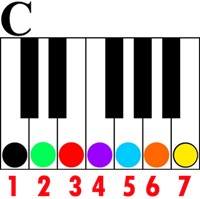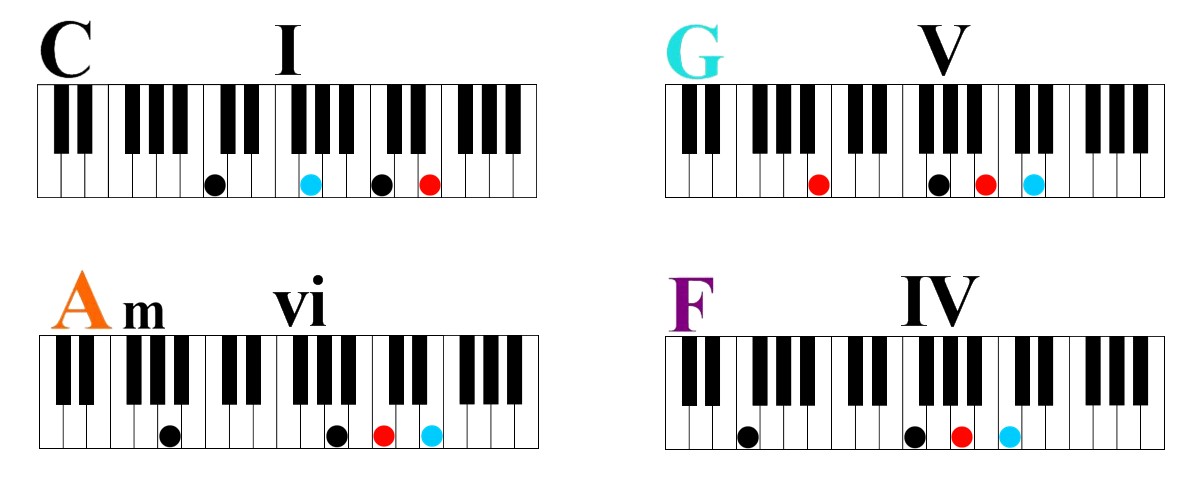Is it possible for a beginner to start playing songs at the piano when they only know four simple chords? Well, we’re not talking about Chopin or Bach. We’re talking about playing beginner chords. They’re actually four simple chords to play hundreds of songs. You don’t have to go through years of traditional piano lessons to develop the skills to do this.
I will say that learning a few basic skills at the piano will make it much easier for you to achieve the goal of being able to play these four simple chords.
First of all, you should know the seven lettered notes in music: A,B,C,D,E,F, and G. That should not be a struggle for you. It’s too easy and basic for you not to take the time to learn them.
Beyond knowing the notes on the piano is understanding the concept of playing in a key of music. All a key of music is a menu of seven different notes in which you choose from. The easiest key for beginners to play in is the key of C Major. This is mainly because there isn’t any combination of black and white keys to confuse a beginner at the piano. 
Whether the key of C Major is the easiest key to play in overall, can be debatable. But you could agree that it is the easiest key to visualize because it consists of all the white notes on the piano keyboard. Just choose any white note and count to seven and then you’re right back where you started.
When it comes to a key of music, it doesn’t begin on an arbitrary note. It has a sequence of notes. That sequence follows the number system. This article is going to focus on the key of C Major. That is, C being 1, D is 2, E is 3, F is 4, G is 5, A is 6 and B is 7.

Each note in a key of music has a corresponding chord. Those chords in the key of C Major are:

Just as important as the chords in the key of music is their number sequence:

When you play any of these chords in a sequence, it’s known as a chord progression. The four simple chords I’m talking about is the 1, 4, 5 and 6 chords.

For now, we’re going to be playing them in this progression or order: 1 5 6 4

In the example above, I’ve represented the chords in the simplest possible voicing. That is, in root position. Chords in root position have the root (the note the chord is named after) on the bottom. This is the simplest way to voice a chord but not the most musical way to play chords in a song. But I think it has value as a tool for understanding chords.
Where on the piano keyboard do you play these chords? As you know without me telling you, there are several registers to an 88 note keyboard. Chords sound best when they’re played closest to middle C. However, you can play them anywhere on the keyboard and there are times when it’s appropriate and even more desirable to play chords in higher registers. You are limited as to playing chords in the lower registers such as the C below middle C. If you play notes that are too close together, it will sound extremely muddy and not like music at all. This is because those lower notes have very slow frequencies that clash when played at the same time. Because of this, it’s very common to play the root of the chord or the root in octaves in your left hand.

So for now, get the sound of these four chords in your ear. The only alteration to the simple chord voicings we’re going to make is to add the root of the chord in the left hand. Just play each chord once and don’t be concerned at this point about playing them with any particular rhythm or with any particular tempo.

Doesn’t that sound a little more musical? Let’s say that you’re familiar enough with these four chords to move on. Next, we’re going to voice them a little bit differently. We want to sound more musical and more professional. Changing the arrangement of the notes in the chords do not redefine the chord. It does redefine how that chord sounds. This is the concept of chord voicings. Let’s take the C Major chord in our right hand and place the root in the middle. If you’re familiar with chord inversions, you know that this is C Major in second inversion. We’re still playing the root in our left hand.

Just by making this simple alteration to the C Major chord, we can smoothly change chords without our right hand having to jump around so much. Now play the progression starting on C Major in second inversion.

Now things are starting to sound more musical. But we don’t have to stop there because chords can be voiced in a variety of ways. The more creative you get with voicings, the more your chords will sound more professional. After some repetition, you should have the sound of these four chords in your hands and also in your ears. Let’s go a little further with chord voicings and play these chords with a more professional sound.
Like I said earlier, changing the arrangement of the notes doesn’t change the chord and that includes adding or omitting some notes. We’ve been playing the root in our left hand up to now. But as you’re going to see, it can make the chord progression sound more interesting just by changing a note or two in our left hand. If we place the B in our left hand when we play the G Major chord, it has a slightly different sound. It also creates a descending quality in the bass. Now get familiar with this latest alteration in voicing.

An interesting thing about a chord progression is that the more you play it, the more your ears become acclimated to hearing it. It then starts playing in your head without your ear actually hearing any sound. How many times has this happened to you? You should be experiencing this by now.
Let’s make one more alteration in voicing to create the smoothest progression possible. This time, let’s voice the F Major chord in first inversion. This way, you’re only moving one note when you transition from the A minor chord to F major chord.

Now that you’re familiar with playing these four chords and the voicing possibilities, it’s time to look at…well time. It’s the pulse of time that music is built upon. The most common pulse in music is multiples of four or four beats per measure. Instead of just playing them at a random pace, count to four beginning at each chord.

Even though you’re playing these chords within a steady pulse of time, they can start to get boring after a few minutes. So how do we play them in such a way that creates interest and sounds like real music? Our next step is rhythm. Playing rhythmic patterns with chords can make a huge difference and they can be played in infinite ways.
The simplest way to play a rhythm is to play a chord on every beat. You can achieve a much better and smoother rhythm if you’re familiar with pedaling. Just simply press down on your sustain pedal on the first beat of the chord and hold it down until the first beat of the next chord. Then repeat the process. It will take some repetition but you’ll get the hang of it.
You can also split the four beat pulse in half by breaking up the chords and playing each beat in two parts. This is known in the music world as eighth notes. Just play the top two notes of the chord in your right hand as you play the bass note with your left. Then play the bottom note of the right hand chord separately. This is a 2/1 breakup.
You can also arpeggiate the chord. This is simply playing the notes of each chord separately. Start from the bottom of the chord and play each note upward.
The title of this article is: Learn four Simple Chords to Play Hundreds of Songs. Those four simple chords do not have to be the 1, 5, 6, 4 chord progression. Just as the notes within chords can be rearranged, the chords themselves can be rearranged to create a new chord progression. But they’re still the same four chords.
Let’s take a look now at the 6, 4, 1, 5 progression. Remember it’s the same four chords. You’ll play this new progression with almost the same voicings that you played in the beginning of the last one.

Can you tell there’s a slight difference in sound? However, they’re the same chords. This expands the possibilities and the variations of songs that use these four chords.
Now play the 6, 4, 1, 5 progression with the same voicing variations and rhythmic concepts as the first progression we looked at. Can you see how these four chords can be played in thousands of songs? If you’re a little skeptical, take a look at this Wikipedia article. You’ll find tons of songs listed with these four chords but it’s by no means a complete list! There are thousands of other songs that have these four chords!
If you’ve gotten this far into the article, you’re serious about learning chords and sounding like a professional at the piano. I want to give you a free gift just for the time you’ve spent here. Click here and I will send you the “Learn 4 Simple Chords to Play Hundreds of Songs” instructional guide. It is a very colorful and illustrated resource with some extras that are not in this article. 
Also, Find out more about Color Score! The easiest way to learn how to play the piano like a professional.
Until next time, Go Play!
Greg Lee
Latest posts by Greg Lee (see all)
- What is a minor/Major 7 Chord? - October 26, 2023
- 7 Chord Substitutions that Professionals Use - October 19, 2023
- 5 Simple Chord Tricks to Sound Amazing - October 5, 2023





